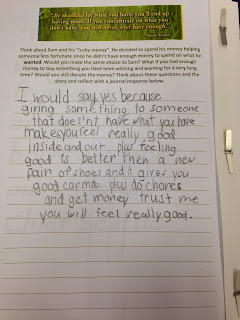Reading With Roald Dahl Bulletin Board

As I researched the man I considered to be one of my favorite authors I realized I fell in love even more. Not only was Dahl a fascinating writer that captured readers' attention with wild and wacky stories, but he had lived the most extraordinary life. I couldn't wait to share it with my students through the Smart Notebook lesson I created.
Afterwards, we took a tour of Roald Dahl's amazing author webpage to explore the many fun activities on the site. It is a tremendous resource for teacher activities and information about the author and his books. In addition, there are fun class games and activities. The first one we took on was a writing exercise. Part of what makes Roald Dahl such a fascinating writer is that he uses interesting language (instead of saying "beautiful" he says "dazzling"). Part of his method was to collect lists of words under a heading. I explained to the class that this was a good exercise for great writers to keep an arsenal of words in case they are ever at a loss of how to put something. As a class we chose to list words that we thought fell under the category of "funny". The students came up with words such as hysterical, hilarious, laughable, unbearable, and goofy. At the end of the lesson I charged the students with never again going with the same old boring funny when writing a story again, but to refer back to our list and use one of our fabulous new and interesting words that mean just the same!
The class is split into three different reading groups. I have a group of readers that are on grade level and we have the pleasure of reading one of my absolute favorites, Fantastic Mr. Fox. The students learned what an antagonist is and discussed what exactly makes someone an antagonist. I put together a study guide that contains not only plot and inferential questions, but also includes activities that have the students looking for and even creating figurative language of their own.
We are still in the midst of reading our books and playing with figurative language. As a final project students will work together as a group to create a sequence of events for the novel within a depiction of our hero, Mr. Fox. Seeing the kids excitement over Roald Dahl and his books has solidified for me that Roald Dahl was successful in his mission: "I have a passion for teaching kids to become readers, to become comfortable with a book, not daunted. Books shouldn't be daunting, they should be funny, exciting and wonderful; and learning to be a reader gives a terrific advantage."
More updates to come as we complete our projects and finish other wacky and wonderful exercises. Next week, the kids will create their own new words and give them life (definitions and illustrations) just as Roald Dahl did!
 |
| Student Worksheet: After students developed a list. They individually selected one to illustrate for our class dictionary. |
 |
| Student Worksheet: Students worked in pairs to come up with their own "gobblefunk". We had a pre-lesson on prefixes and suffixes. |

.JPG)
.JPG)



















